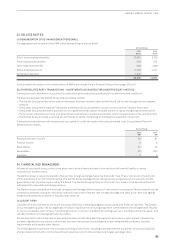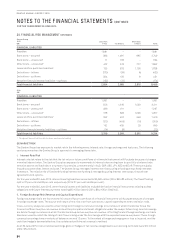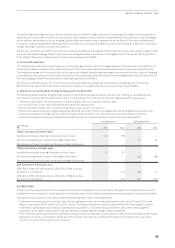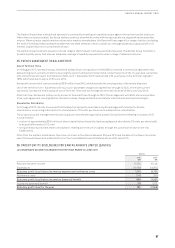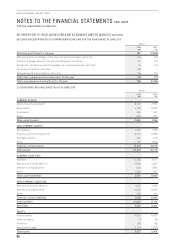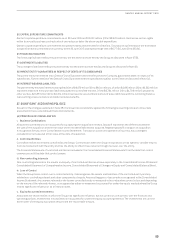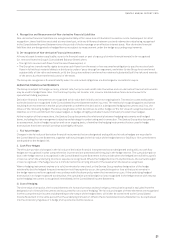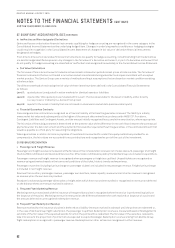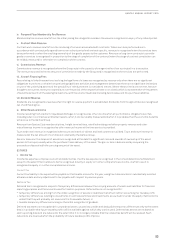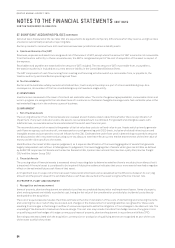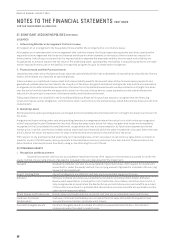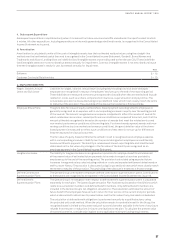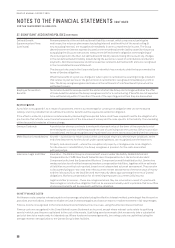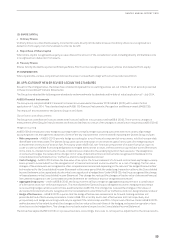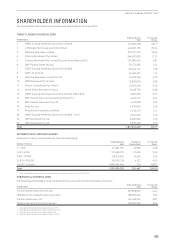Qantas 2015 Annual Report Download - page 94
Download and view the complete annual report
Please find page 94 of the 2015 Qantas annual report below. You can navigate through the pages in the report by either clicking on the pages listed below, or by using the keyword search tool below to find specific information within the annual report.
93
QANTAS ANNUAL REPORT 2015
iv. Frequent Flyer Membership Fee Revenue
Membership fee revenue results from the initial joining fee charged to members. Revenue is recognised on expiry of any refund period.
v. Contract Work Revenue
Contract work revenue results from the rendering of services associated with contracts. Where services performed are in
accordance with contractually agreed terms over a short period and are task specific, revenue is recognised when the services have
been performed or when the resulting ownership of the goods passes to the customer. Revenue on long-term contracts to provide
goods or services is recognised in proportion to the stage of completion of the contract (when the stage of contract completion can
be reliably measured) or otherwise on completion of the contract.
vi. Commissions Revenue
Commissions revenue is recognised where the Group acts in the capacity of an agent rather than a principal in a transaction.
Therevenue reported is the net amount of commissions made by the Group and is recognised as the services are performed.
vii. Aircraft Financing Fees
Fees relating to linked transactions involving the legal form of a lease are recognised as revenue only when there are no significant
obligations to perform or refrain from performing significant activities and management determines there are no significant limitations
on use of the underlying asset and the possibility of reimbursement is considered remote. Where these criteria are not met, fees are
brought to account as revenue or expenditure over the period of the respective lease or on a basis which is representative of the pattern
of benefits derived from the leasing transactions, with the unamortised balance being held in lease and hire purchase liabilities.
viii. Dividend Revenue
Dividends are recognised as revenue when the right to receive payment is established. Dividends from foreign entities are recognised
net of withholding tax.
ix. Other Revenue/Income
Income resulting from claims for liquidated damages is recognised as other income when all performance obligations are met,
including when a contractual entitlement exists, when it can be reliably measured and when it is probable that the economic benefits
will accrue to the Qantas Group.
Revenue from Qantas Club membership fees, freight terminal fees, retail/advertising and other property revenue and other
miscellaneous income is recognised as other revenue/income at the time service is provided.
Tours and travel revenue is recognised when tours and travel air tickets and land content are utilised. Tours and travel revenue is
measured at the net amount of commission retained by the Qantas Group.
Gains or losses on the disposal of assets are recognised at the date the significant risks and rewards of ownership of the asset
passes to the buyer, usually when the purchaser takes delivery of the asset. The gain or loss is determined by comparing the
proceeds on disposal with the carrying amount of the asset.
(E) TAXES
i. Income Tax
Income tax expense comprises current and deferred tax. Income tax expense is recognised in the Consolidated Income Statement
except to the extent that it relates to items recognised directly in equity or in other comprehensive income, in which case it is
recognised in equity or in other comprehensive income.
Current Tax
Current tax liability is the expected tax payable on the taxable income for the year, using tax rates enacted or substantially enacted
at balance date and any adjustment to tax payable with respect to previous years.
Deferred Tax
Deferred tax is recognised in respect of temporary differences between the carrying amounts of assets and liabilities for financial
reporting purposes and the amounts used for taxation purposes. Deferred tax is not recognised for:
–temporary differences arising from the initial recognition of assets or liabilities that affect neither accounting nor taxable profit;
–temporary differences relating to investments in controlled entities and investments accounted for under the equity method to the
extent that they will probably not reverse in the foreseeable future; or
–taxable temporary differences arising on the initial recognition of goodwill.
Deferred tax assets are recognised for unused tax losses, unused tax credits and deductible temporary differences only to the extent
that it is probable that future taxable profits will be available against which they can be used. Deferred tax assets are reviewed at
each reporting date and are reduced to the extent that it is no longer probable that the related tax benefit will be realised. Such
reductions are reversed when the probability of future taxable profits improve.


